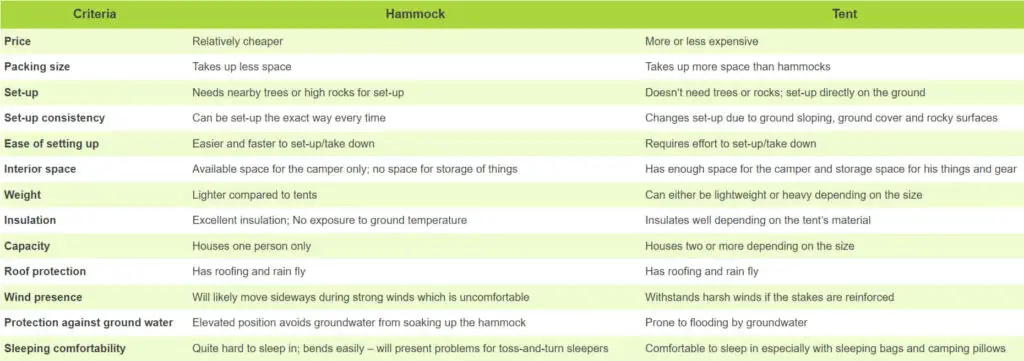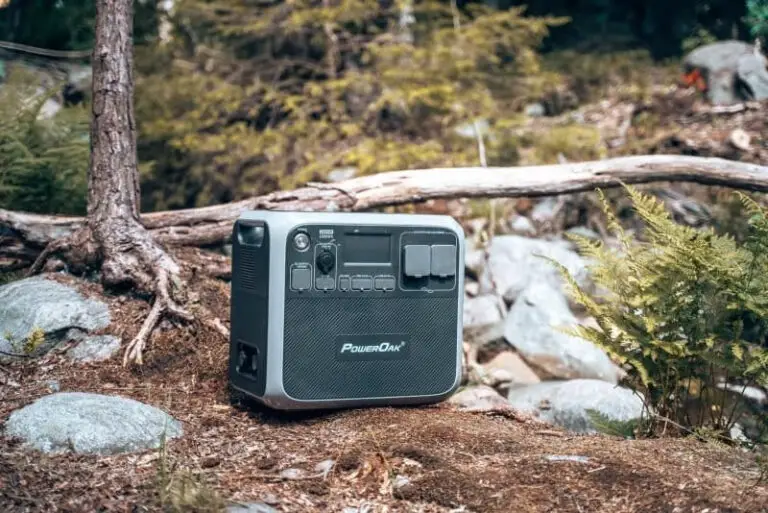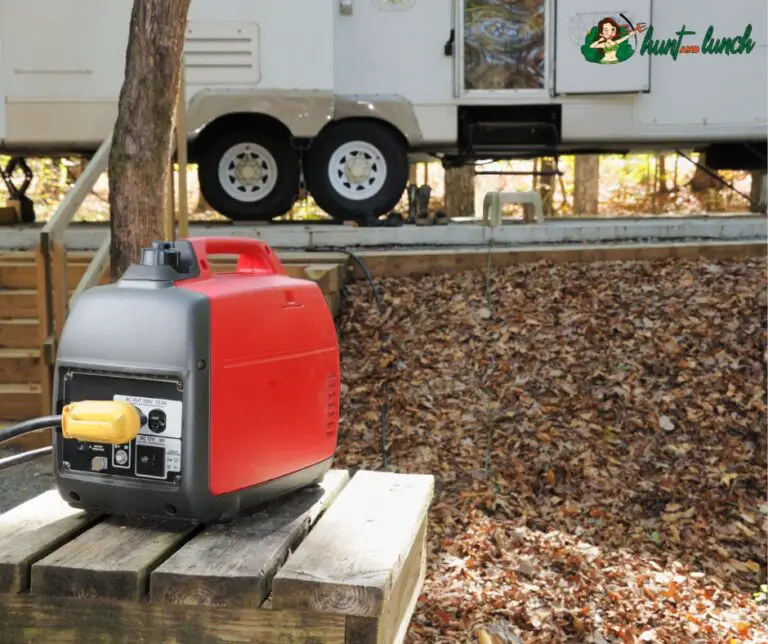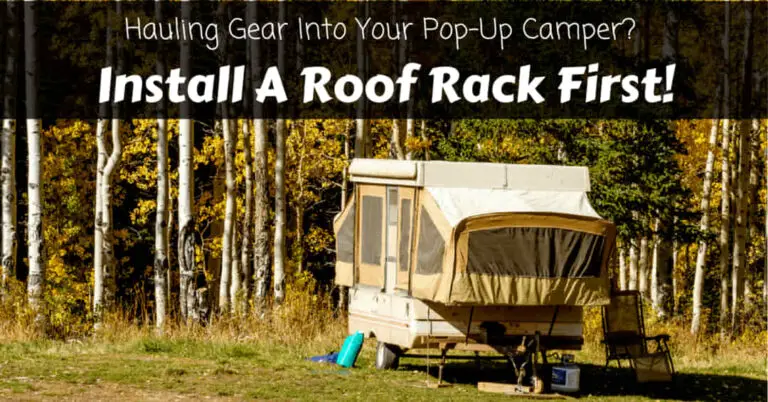
A large number of things on Earth are debatable these days – iPhone vs. Samsung (I’m pro-iPhone), whether or not pineapple goes with pizza (definitely!), tablets vs. textbooks (books, definitely. Old school’s the best), etc.
You see, these are easy topics, ones you can think over for a day. But hard ones like going vegan, legalization of marijuana, the right to abortion, and hammocks vs. tents will get your brains all worked out particularly hammocks vs. tents. The phrase alone stumped me.
Hammock or tent?
As an avid camper since my younger years, I was used to using tents for every outdoor activity. My dad, my grandpa and his father before him all used tents, so I grew up camping in a tent. We’re always told that if you’re backpacking and travelling without an RV, a tent is the only way to camp out. Little did I know that you can also use a camping hammock.
I know what you’re thinking, and you’re right – I’m talking about the beach-type that you tie on trees, can be rocked back and forth and makes you sleep like a baby.
Some campers swear that camping hammocks are better than tents. They’re lighter, more compact, and easier to install and take down. I’ve had my fair share of using camping hammocks, and I can say that it does the job of ensuring a wonderful sleep. But there are also cons to using a hammock too which I’ll elaborate further later.
The crucial thing is to realize that switching to a hammock and setting the tent aside doesn’t mean sacrificing the comforts provided by your tent for a minimalistic camping approach because using hammocks have distinct benefits too. What’s hard is to head out into the great outdoors and leaving the one thing you’ve always relied on.
Hammocks VS. Tents

Distinct Features of Hammocks
1. Lighter than tents
A camping hammock weighs less than one pound while a tent may be a little over four pounds. But of course, you can’t leave behind the hammock’s straps, flysheet or tarp, and other stuff used for attaching it. The tent may be relatively heavier than the hammock but a four-pound tent set already includes the stakes, fly sheets, and poles. That’s a tie right there.
2. Easier to set-up
Just lay the hammock flatly on the ground, choose a suitable height, tie opposite ends on sturdy trees or rocks, and you’re done. Obviously, it’s 10x easier to set-up a hammock than a tent. Similarly, it’s quicker to take it down than a tent.
Moreover, since the hammock is elevated, you can rest easy knowing that wandering bears, foxes, and deer can’t sneak inside your shelter and get food or worse, maul you. Kidding!
3. You can float
Apparently, a hammock is designed to float. Its floating capability attracts campers and non-campers alike to choose it over a tent. The ground may be unforgiving – full of rocks and debris, uneven slopes, rough surfaces, and pointy vegetation covers. With a hammock, you can just ignore all of those things and find a high tree or rock to tie your hammock straps into.
In contrast, a soft patch of rockless and vegetation-less ground is hard to find thus to set up a tent, you need to scout for a decent spot first then remove all debris in the area before you can actually begin setting-up.
4. Insulation
A great feature of camping hammocks is insulation. The ground tends to be colder longer than air and water especially during spring because of the soil’s heat capacity. Camping directly above the cold ground will definitely give you chills. You’ll need extra insulating materials like another layer of a sleeping bag and layers upon layers of thick clothing to sleep comfortably inside your tent.
Fortunately, you can skip doing things like that with a hammock. They’re elevated above ground, making it a less cold than sleeping inside a tent though you still need to wear thick jackets and scarves. Also, may opt not bring a sleeping bag if you’ll be using a hammock because it’s quite chunky, but you may do so according to your preference. Likewise, a hammock is especially useful during summer camps because it permits more exposure to fresh air than a closed tent.
5. Protection against ground or surface water
It’s inevitable to wake up to a wet tent caused by overflowing of nearby lakes and beaches. If you don’t have a tent tarp underneath your tent, water will surely soak the underside of the tent. With a hammock, you can sleep soundly without worrying about wetting your tent the following morning.
Cons of Using Hammocks
1. What if there are no high trees or rocks on the site?
This is where the problem comes in. What are you going to do if you’re on a bald mountain and only bushes were abundant? With no trees nor high rocks to attach your hammock into. You can’t just lay your hammock on the ground and sleep in it because it won’t provide any insulation, protection, and comfort.
Perhaps, this is the greatest con of using hammocks which, on a brighter note, makes it an edge for tents. With a tent, you can camp out anywhere – from forests and trails to beaches and campgrounds.
2. Houses a single person only
Hammocks are designed to shelter just one person. It has a smaller space compared to tents. Since it assumes a curved banana shape when hung, the hammock’s sides will flap when you lay on it, leaving no space for others.
Moreover, you’re forced to leave your things on the ground unguarded because apparently, you can’t squeeze it with you on the hammock. A hammock lacks storage space too. You may opt to hang your essentials on nearby trees, but it’ll be hard to access when you need it because you have to get down and get it unless you can reach it with your hands.
For that matter, another point goes to the tent.
3. A hammock sways with the wind
Have you ever slept in a hammock during strong winds? If you haven’t, I suggest never attempt to try it. It’s shaky and very uncomfortable even with a large well-pitched tarp or flysheet above. Make sure to reinforce your tarp with additional stakes that are deeply buried in the ground during windy and rainy conditions.
Likewise, a tent needs to be reinforced and pitched well enough during harsh conditions.
Read More: Leisure and Adventure in One: The Letchworth State Park
The Verdict
So.. what’s the best camping shelter?
The one in front? Or the blue one behind? (pictured above). Sorry to disappoint you readers but the award goes to…. our old, reliable tents. Though they add more weight to our packs, they compensate for the utmost comfort they provide us with.
Tents can be laid anywhere, shelter two or more people, provide storage space for our things, insulate and protect us well, withstands winds and other outdoor elements, and finally, they’re not that hard to set-up and uninstall either.
Let’s stick to the old style, shall we? Admit it, it’s hard to leave your tent behind and risk sleeping in a camping hammock. I find hammocks ideal during day camps and chilling on the beach but never for overnight camping trips that may last for a day or two. Also, hammocks are great for sleeping in during afternoons when air gets humid inside the tent.
Based from my own and my other camper friends’ experiences, two reliable and highly-rated hammocks that will make sleeping effortless are the Bear Butt Double Hammock and the Camping Hammock by Wise Owl. Bring your hammock together with your tent if you have space to spare for the best weekend trip!
Hey there! So what’s your vote – tent or hammock? Why? Have you used these two before? Share your experiences with them below!
And one more thing. Let’s spread this awesome content by sharing this article, yes? We’d really appreciate it. Cheers!

I’m Cindy, a free-spirited outdoor enthusiast. Since childhood, Our family frequently goes on weekend camps and my father, who was a skilled hunter, used to teach my siblings and me valuable things about wildlife survival. I made this blog to share my knowledge, experiences, and tips.






